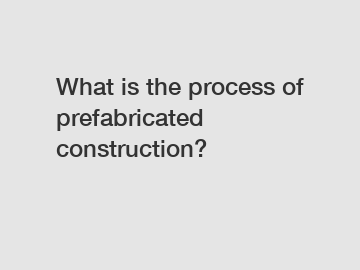What is the process of prefabricated construction?
What is the process of prefabricated construction?
Prefabricated construction, also known as modular construction, is a revolutionary approach to building structures. It involves assembling various components of a building in a controlled factory environment and transporting them to the construction site for final installation. With its numerous benefits and streamlined process, prefabricated construction has gained immense popularity in recent years. So, what is the process that makes this construction method so efficient and cost-effective? Let's delve into the details.
1. Design and Engineering:

The prefabricated construction process begins with meticulous design and engineering. Architects and engineers collaborate to create a detailed plan that incorporates the desired specifications and requirements. This stage involves determining the type of building modules, the materials that will be used, and the overall layout of the structure.
2. Manufacture of Building Components:
Once the design is finalized, the manufacture of building components commences. Walls, floors, roofs, and other necessary elements are constructed in a factory setting. These components are produced with precision and high-quality materials, ensuring consistency and strength.
3. Integration of Building Services:
Prefabricated construction also involves the integration of building services into the manufactured components. Electrical wiring, plumbing, and HVAC systems are pre-installed within the building modules. This integration helps streamline the construction process, eliminating complex on-site installations and minimizing costly delays.
4. Transportation to the Construction Site:
After the building components are manufactured and services are integrated, they are transported to the construction site. This transportation process can occur via trucks, trains, or even ships, depending on the project's location and size. Shipping the components to the site reduces on-site material storage requirements and congestion, leading to better project management.
5. On-Site Assembly:
Upon arrival at the construction site, the prefabricated building components are efficiently assembled to form the final structure. The assembly process is relatively quick and straightforward compared to traditional construction methods. The use of bolted or welded connections ensures structural integrity, creating sturdy and reliable buildings.
6. Finishing Touches:
Once the main structure is assembled, the finishing touches are added to complete the building. This includes applying external finishes, like cladding or paint, and fitting interior fixtures such as doors, windows, and flooring. The final steps also involve connecting the pre-installed building services to the utilities at the site.
7. Quality Control and Inspection:
Prefabricated construction places high emphasis on quality control. During the manufacturing process, components undergo rigorous inspections to ensure adherence to design specifications and building codes. After assembly, the finished building is thoroughly inspected to guarantee its structural integrity, safety, and compliance with regulations.
8. Advantages of Prefabricated Construction:
Prefabricated construction offers numerous advantages over traditional construction methods. First and foremost, it significantly reduces construction time. With simultaneous manufacturing and site preparation, projects can be completed in a fraction of the time required for conventional construction. This time-saving factor leads to lower costs and faster returns on investment.
Additionally, the controlled factory environment of prefabricated construction ensures superior quality control. Building components are manufactured to precise standards, free from weather-related damages that can occur during on-site construction. Moreover, this method reduces waste generation and promotes sustainability, as materials are efficiently utilized and excess waste is minimized.
Prefabricated construction can also enhance safety on construction sites. Since a significant portion of the construction work is done off-site, workers are exposed to fewer hazards commonly associated with on-site construction, such as working at heights or in adverse weather conditions.
In conclusion, the process of prefabricated construction involves meticulous design, factory fabrication of building components, transportation to the construction site, on-site assembly, and finishing touches. This construction method offers various advantages, including reduced construction time, improved quality control, sustainability, and enhanced worker safety. As the demand for efficient and cost-effective building solutions rises, prefabricated construction continues to be a viable option for the future of the construction industry.
The company is the world’s best Wholesale Space Frame, space frame roof construction, Space Frame Structures For Industrial Plants supplier. We are your one-stop shop for all needs. Our staff are highly-specialized and will help you find the product you need.

Comments
0